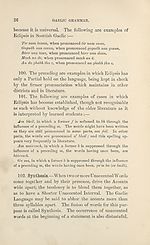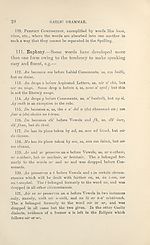Download files
Complete book:
Individual page:
Thumbnail gallery: Grid view | List view

WORDS IN COMPOSITION.
27
Words which coalesce with each other, are written close
together, and a sign called the Apostrophe, put in the
place of the part left out. The parts of words so left
out, are sometimes difficult to reinstate, and require
knowledge of the older language; but in most cases, the
reinstatement is easily done.
103. Words ending in Vowels before words beginning
in Vowels, are most liable to Synthesis, as, do'n for do an,
d’iarr for do iarr, dfhaod for do fhaod, m’bglach for mo
bglach, b’fhearr for bu fhharr.
104. In some cases, words ending or beginning with
consonants, coalesce with others, as, ’nan for aim an,
’nod for ann ad, ri d’ for ri do, ’san for anns an, ’gan for
ag an, ’nuair for an uair, ’s trie for is trie.
105. In some cases, as many as three words are
blended into one syllable, as, gum b'eiginn for gu am bu
digilt n, gu’n d’fhalbh for gu an do fhalbh.
106. It is quite evident that many of the more
commonly used words have come to their present forms
through Synthesis. Their elements are not always
recognisable. Some may be got at by the study of
the older language; and some suggest their elements
in their meaning, as, agam for ag mi, at me; learn for
le mi, with me, etc.
107. Grades of Composition.—Composition may be
regarded as of Three Grades, namely :—
108. Loose Composition, exemplified by air mo chois chl\, where
the words influence one another without absorbing parts of each
other.
109. Close Composition, exemplified by combinations like
do'n, Vfhearr, ’san, etc., where the words are absorbed by one
another in such a way that the parts lost may be indicated by
an Apostrophe.
27
Words which coalesce with each other, are written close
together, and a sign called the Apostrophe, put in the
place of the part left out. The parts of words so left
out, are sometimes difficult to reinstate, and require
knowledge of the older language; but in most cases, the
reinstatement is easily done.
103. Words ending in Vowels before words beginning
in Vowels, are most liable to Synthesis, as, do'n for do an,
d’iarr for do iarr, dfhaod for do fhaod, m’bglach for mo
bglach, b’fhearr for bu fhharr.
104. In some cases, words ending or beginning with
consonants, coalesce with others, as, ’nan for aim an,
’nod for ann ad, ri d’ for ri do, ’san for anns an, ’gan for
ag an, ’nuair for an uair, ’s trie for is trie.
105. In some cases, as many as three words are
blended into one syllable, as, gum b'eiginn for gu am bu
digilt n, gu’n d’fhalbh for gu an do fhalbh.
106. It is quite evident that many of the more
commonly used words have come to their present forms
through Synthesis. Their elements are not always
recognisable. Some may be got at by the study of
the older language; and some suggest their elements
in their meaning, as, agam for ag mi, at me; learn for
le mi, with me, etc.
107. Grades of Composition.—Composition may be
regarded as of Three Grades, namely :—
108. Loose Composition, exemplified by air mo chois chl\, where
the words influence one another without absorbing parts of each
other.
109. Close Composition, exemplified by combinations like
do'n, Vfhearr, ’san, etc., where the words are absorbed by one
another in such a way that the parts lost may be indicated by
an Apostrophe.
Set display mode to:
![]() Universal Viewer |
Universal Viewer | ![]() Mirador |
Large image | Transcription
Mirador |
Large image | Transcription
| An Comunn Gàidhealach > An Comunn Gàidhealach Publications > Scottish Gaelic as a specific subject > (31) |
|---|
| Permanent URL | https://digital.nls.uk/125955389 |
|---|
| Description | This contains items published by An Comunn, which are not specifically Mòd-related. It includes journals, annual reports and corporate documents, policy statements, educational resources and published plays and literature. It is arranged alphabetically by title. |
|---|
| Description | A collection of over 400 items published by An Comunn Gàidhealach, the organisation which promotes Gaelic language and culture and organises the Royal National Mòd. Dating from 1891 up to the present day, the collection includes journals and newspapers, annual reports, educational materials, national Mòd programmes, published Mòd literature and music. |
|---|---|
| Additional NLS resources: |
|

